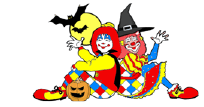There are many artistic, elaborate clown faces out there. Indeed, some clowns are walking works of art-their makeup is flawless and amazing. The hospital clown, however, must proceed with caution. During hospital clown training we were taught to avoid full-face makeup. They showed us how to use our natural facial structure to apply our clown face.
Nurse Lulu's favorite makeup: Ben Nye three-color makeup wheel
We were to make various facial expressions in front of a mirror, taking note of our musculature as we did so. We would then apply makeup sparingly, using only two or three colors. Full white face was especially discouraged. Our noses were chosen according to preference and practicality. The makeup style would also change with time, experience and character development. Hospital clowning is close up and I’ve found that even adults without long-standing clown phobias become startled at the sight of a fully made up clown face. (For reasons related to hygiene and cross-contamination, we do not use wigs in the hospital, but we do use hats.) Check out Nurse Lulu's finished face in the hospital dressing room:
Approach is also critical in hospital or other close-up clowning. The clown must pay close attention to a child’s (or even an adult’s) facial expressions and body language. Generalized tension or a sudden negative change is a clear “do not approach” message. If they demonstrate cautious curiosity, distance clowning is advised. In the hospital we are always in pairs, so playing off each other using gags or magic tricks, singing or juggling is effective, with a wave while walking away when you’re done.
If a cautious little one is intrigued, it is best to physically [while keeping your distance] move down to their eye level so you don’t seem menacing. You must then let them approach you if they choose to. We never jump out at anyone or surprise them or make sudden loud noises in a hospital setting, [although it is safe to sing or do physical comedy in some areas], and this practice is best for any close-up clowning.
While strolling through hospital hallways, a pair of clowns can be singing or joking around (because you are always “on”), but at least one of them should always be aware of their surroundings not only for safety, but for sensitivity. If there is a person, couple or group of people crying or otherwise in despair, levity should be dropped and the clowns should pass them by unless they are requested. Devastating news is all around in a hospital setting and must be treated with great care and respect.
 Lucy E. Nunez has been a theatrical performer since 2002 and created Nurse Lulu for the Big Apple Circus Clown Care program in 2014. For more information please visit: www.sunnybearbuds.wix.com/buds
Lucy E. Nunez has been a theatrical performer since 2002 and created Nurse Lulu for the Big Apple Circus Clown Care program in 2014. For more information please visit: www.sunnybearbuds.wix.com/buds
